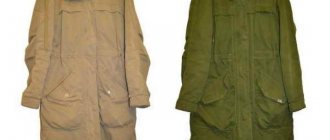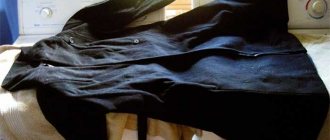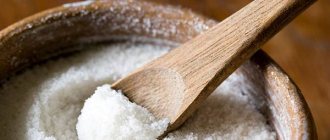You can clean a wool coat at home using a wet or dry method. The choice depends on the degree of contamination, the nature of the stains, recommendations for caring for the product from the manufacturer, the composition and color of the fabric. They try not to put outerwear made from natural materials at risk and take it to the dry cleaner, but minor stains can be easily removed on your own.
To avoid damaging the fiber structure, use a sponge or soft brush
General recommendations
Cleaning a coat at home provides general principles. The sequence of actions is observed.
- The coat is placed on hangers, and a visual assessment of the condition of the product is carried out.
- The label containing information about the type of material is examined. It indicates whether the coat can be washed in a washing machine or whether dry clean only is recommended.
- After selecting cleaning products, check their effect on the fabric in an inconspicuous place.
- If you need to remove a stain, make all cleaning movements towards the center.
- Before cleaning your coat, you should trim the lining. This will allow you to place a cloth inside when processing contaminants.
Removing stains
Often outerwear is covered in stains, which can be removed depending on the type of contamination.
- Grease stains are best removed with gasoline. A small amount of the substance is applied to a cotton swab, after which it is used to wipe off the dirt from the underside of the product. Before you begin, you need to place a piece of cotton cloth under the stain to absorb excess liquid.
- Sweat stains can be removed using a soap solution and a cotton swab. The dirt is carefully wiped off, after which the remaining soap must be removed with a damp cloth.
- Contaminants left by wine, beer, tea or coffee are removed with a mixture of glycerin and ammonia (1:2 ratio). Use the resulting product to wipe the stain until it disappears completely, and then blot the fabric with a dry, clean cloth.
Before thorough dry cleaning of the coat, it is necessary to examine the product for the presence of pronounced stains and remove them. The process of removing contaminants begins with a thorough inspection of outerwear under fluorescent lamps. Mark the problem areas on your clothes and follow the rules below on how to clean a wool coat from stains at home:
To eliminate a stain, it is necessary to treat the contaminated area, starting not from the middle, but from its borders. This will prevent uneven cleansing, which often results in small residual marks at the edges of the stained area or messy streaks. If you remove the stain from the wrong side, the work will take much less time. The chemical reagent or other agent used will gradually push out the deeply seated stain from the inside of the weave of the fibers
Pay great attention to the choice of stain remover; it is best to use alternative methods of removing stains. Before treating a stained area of material, check the durability of the dye by testing the selected product on the wrong side of the product
Note to the housewife: When wearing woolen coats with a pile, local areas of clothing, such as the elbow bend, cuffs, pocket area and the inside of the collar, are often rubbed to an untidy shine. Shine is removed by steaming and treating the fabric with table salt using a stiff brush.
Got a stain? Once it is removed, the entire coat may need to be washed. How to remove stains depends on the “nature of their origin.”
- First, you can try to remove the stain using an iron and white paper napkins: cover the stain with the napkin and iron it. Has the fat transferred to the paper? Then repeat the process several more times, changing napkins.
- You can try to neutralize fat with talcum powder: sprinkle it on the dirt and leave it for a couple of hours. Then remove the talc with a dry brush. Instead of talcum powder, potato starch is suitable. If the entire stain cannot be removed at once, this procedure can be repeated.
- But most often, oily stains are removed with purified gasoline. The dirt is wiped off with a cotton swab soaked in gasoline. Moreover, this must be done from the wrong side of the fabric, having previously placed a cotton cloth under the stain, which will absorb the moisture. If the coat has a lining, it must be carefully torn off under the stained area. Clean stains from the outer edges to the center so that there is no halo left.
If there are stains from coffee and tea, they can be removed with glycerin and ammonia: take in a ratio of 1:2 (a spoonful of glycerin and half a spoonful of alcohol). Or a solution of vinegar and alcohol (1:1). The same mixture should also remove beer stains. Hydrogen peroxide can also remove it. But the trace of wine needs to be covered with table salt, then the salt should be removed and the area of contamination should be washed with cold water (wipe with a damp foam sponge).
A mixture of salt and ammonia (4 teaspoons of salt and 1 teaspoon of ammonia) will help clean greasy areas (collar, sleeves, pockets).
The stains have been removed, now you can start washing.
How to clean a drape
Due to its dense structure, a drape coat can be cleaned quite simply. Use a brush to remove dust and debris. Rolled rye bread crumb will remove minor stains. This ball is rolled over the entire surface of the product.
The dry wash method is acceptable. Washing powder is scattered over the coat laid out on the table. After half an hour, brush off the product with a soft brush.
If stains are found on the drapery, moisten them with detergent and leave for 10 minutes. After this, the contaminated area is carefully wiped with a clean, damp sponge and dried on a hanger. Wash your drape coat at home by hand in warm water (≈ 30 °C) only if absolutely necessary.
Getting rid of stains
Most often, 2 types of local contamination appear on the coat: traces of dirt and stains of various origins. The choice of means to combat them depends on the color of the product and the fabric from which it is made.
A clothes brush often works well for removing street dirt. If dirt gets stuck in the pile, you can remove it with soap foam.
It should be remembered that you first need to dry the fabric before proceeding with any processing. Otherwise, the stain will penetrate even further into the matter.
To clean stains of various origins, gentle stain removers are usually used at home. If their use is prohibited, folk remedies will help. Before use, any of them must be tested on an inconspicuous area of the product.
A strong solution of table salt will remove fresh sweat stains from any fabric. After the procedure, the tissue is washed with water.
Entrenched contaminants are removed in different ways:
- A coat made of cashmere or other light woolen or wool blend fabric will be renewed with ammonia with glycerin (1:1) or table salt dissolved in water (1 tsp per glass). The mixture is also suitable for cleaning models made of suede, synthetics, and cotton fabrics, for example, moleskin, corduroy, and diagonal.
- Yellow stains from colored and dark things can be removed with gasoline, ammonia or acetone.
- The newly formed oil stain is covered with starch or baby powder. After two hours, the powder is cleaned off with the rough side of a dishwashing sponge or brush. For those products that are not afraid of ironing, the stain is covered with napkins on top and bottom, and then ironed with a hot iron. The paper that has absorbed grease is changed periodically.
Old stains from light-colored coats are removed with a paste of chalk (talc) and gasoline. The composition is spread in a thick layer on the problem area and shaken off after complete drying. If necessary, the procedure is repeated 2-3 times.
Dark fabrics are cleaned with turpentine, gasoline, acetone in pure form or in combination. The front side of the product is covered with a napkin, and cleaning is carried out from the back. After removing the fat, apply a cotton swab soaked in water to the material.
- The choice of means and method of cleaning from traces of rust, paint and ink depends on the color of the item. Suitable for light: 1 tsp. citric acid or hydrosulfite, dissolved in 200 ml of hot water or heated lemon juice.
A coat of any color will not be ruined (unless a trial test shows otherwise):
- Acetic essence or denatured alcohol, diluted with water 1:2.
- Warm milk or curdled milk.
After any treatment method, the area is washed with water or a weak solution of ammonia.
- You can clean coats made of light wool or other fabrics from wine and berry stains by sprinkling them with table salt. Remove old stains with a solution of citric acid (1 teaspoon per glass of hot water).
Stains from dark-colored products are removed with pure glycerin or its mixture with egg yolk. The product is applied to the stain and left for several hours. Then its remains are removed with water.
- A solution of table vinegar can deal with salt stains on leather items. Suede should be cleaned with lemon juice diluted with water.
Gasoline and most solvents are incompatible with water, so you can only clean dry things with them, moving from the edges of the dirt to the center.
Cleaning Cashmere Products
You can wash a cashmere coat in a machine if there is no prohibiting symbol on the label. Wash at 30°C using mild detergents. Select the delicate wash mode without spinning.
We recommend reading: A simple solution to a difficult problem: what to do if brilliant green gets on your clothes
Dry the coat on a horizontal plane, spread out, with a terry sheet underneath. You can iron with steam without touching the cashmere with the soleplate of the iron.
Greasy marks can be removed with gasoline. Another option is to sprinkle talc on the stain for 12 hours. Then clean the dirt with a soft bristle brush. To remove contaminants of an unknown nature, soak the mark with a soap solution. After this, wipe the affected area with ammonia. Finally, remove traces of used compounds with a damp cloth.
How to wash a coat at home
Recommendations for washing coats made from different types of fabrics:
- Wash draperies at home by hand, at 30–40°C, with detergents for woolen items (Perwoll, Frosch). Then rinse in clean water and dry in the fresh air, hanging on a hanger.
- Suede items cannot be washed. If the clothes are very dirty, rinse them in a 30-degree soap solution (2 tbsp soap/1 tbsp liquid), and then again in water with glycerin (1 tsp/1 l liquid). Then blot the product with a dry towel and dry it by laying it on a horizontal plane.
- Tweed items cannot be soaked or washed. If the clothes are very dirty, rinse them by hand in warm water (30°C) with the addition of detergent for woolen items ( Royal Powder Delicate ). Iron tweed items only from the inside out, through damp gauze.
- Wash polyester items by hand or in a machine on the delicate cycle for synthetic items at 30°C. Use liquid, gel detergents that do not contain bleach ( Ariel, Persil, Tide ). After washing, do not wring out the clothes under any circumstances. Dry the items by laying them out on a horizontal plane and iron them at the lowest temperatures through cheesecloth.
- Neoprene items are covered with fabric on both sides, so they do not get wet through. At home, be sure to wash them on both sides: first on the front, then on the back. Do this manually (at 30°C) or in an automatic machine on a delicate mode without spinning. Carry out the procedure using liquid detergents for washing baby clothes ( I was born, Stork, AQA Baby ). Dry the neoprene product also on both sides, so that it is not exposed to direct sunlight.
- It is better to dry clean white woolen items. If you wash them with your own hands, they may become dull and gray. At home, you can only wash dark-colored woolen items. To do this, add powder (1 tbsp/1 liter of liquid) to warm water (30°C), place clothes there and remember lightly. Then rinse with fabric softener. Dry woolen items horizontally, placing them on top of a towel.
- Cashmere clothing can be washed by hand and in an automatic washing machine, but only if there is a corresponding icon on the label. The procedure is carried out at a water temperature of no more than 30°C, using liquid detergents for woolen items ( Perwoll, Frosch ). When using a washing machine, select the delicate mode without spinning. For hand washing, fill the bathtub with water, dilute detergent in it (2-3 tablespoons/1 liter of liquid) and soak the cashmere coat for 20 minutes. Rub heavily soiled areas (collar, sleeves) with a soft sponge. Then rinse your clothes in cool water. After washing, without wringing out, hang it on a hanger above the bathtub (for 10–15 minutes). When the water has drained, transfer it to a dry towel and change it as it gets wet. Iron a damp cashmere item through gauze folded in 2-3 layers.
- Leather clothing cannot be washed. For thorough cleaning, it is better to take things to dry cleaning. At home, you can clean only the lining. Turn the garment inside out and wet the lining fabric. Using a sponge, apply a solution of 2 tbsp to the contaminated areas. l. liquid soap and 1 tbsp. water. Lightly rub problem areas. Remove any remaining solution with a damp cloth. Hang the coat to dry on a hanger. Make sure that there are no heating devices or sudden temperature changes in the room. Otherwise, the material may stretch or shrink.
General Methods for Cleaning a Wool Coat
To restore shiny areas to their former appearance, wipe them with a napkin soaked in tea leaves or a mixture of vinegar and alcohol (1:1).
When deciding how to clean a coat collar or restore worn areas on the sleeves, prepare a solution of salt in ammonia (1:4) for wiping.
If, judging by the label, you can wash the coat in an automatic washing machine, set the temperature to a maximum of 30° C. The product must not be wrung out. This condition is also observed when washing by hand, which is preferable to machine washing. You should also not rub the product. Dry only on a horizontal surface.
Features of washing coats of different colors
The color of the product affects the method of cleaning and application of products.
Light shades
Light-colored items require careful washing and rinsing with soapy water. The wrong technology will turn white into grey.
White drape allows the use of powder with bleaching agents or regular laundry detergent. The product is applied to the stain, rubbed in a little and removed with a brush after half an hour.
Coat of dark shades
The drape is cleaned with carpet powder. The product is pre-mixed with water and whipped until foamy. It is this that is applied to the stain and then removed with a brush.
Black tea is also used: take a cotton pad and dip it in the strong drink, wipe off the dirt and let it dry.
Cleaning a leather coat
Flexible and durable, genuine leather is easy to clean if certain rules are followed.
Wiping with a damp soft cloth will help you get rid of dusty marks. If the contamination is small, dissolve a tablespoon of alcohol in a glass of water and add two tablespoons of liquid soap. Wet the sponge and treat the skin with the resulting composition. Then wash off the traces with clean water. Leather products should be cleaned regularly using this method.
Greasy areas are treated with alcohol, then wiped with lemon juice and additionally soaked in glycerin.
Salt stains remaining on the skin after rain are removed by table vinegar (6%).
You can't wash your coat in a machine, but you can try a gentle hand wash to tidy up the dirty lining. To do this, leather clothing is turned inside out. The lining is soaked and soaped using laundry soap. After washing, rinse, trying not to get the item too wet. Drying a leather coat on hangers.
We recommend reading: How to properly wash a coat at home?
Removing the smell
Outerwear, especially wool coats, absorbs a variety of odors, including sweat and cigarette smoke. Ventilation usually helps get rid of them. But there are other effective ways.
From sweat
Eliminates the smell of sweat from a coat:
- Universal aerosol for fabric with silver ions. Spray the product onto the armpit area and wait until it dries completely.
- Activated carbon. The problem areas of the coat, laid out with the lining up, are sprinkled with powder from several tablets. After 2-3 days, the coal is removed.
- A solution of ammonia or vinegar. The product is diluted in water (2 tablespoons per 200 ml) and, after moistening a sponge in the composition, treat unpleasant-smelling areas. Then the coat is aired for 6-8 hours.
- Baking soda. It is poured onto areas of the lining that are damp from sweat at night. In the morning, shake off the crystals with a brush.
- Lemon juice or citric acid. Rub the liquid onto bad-smelling areas and allow them to dry. To enhance the effect, vinegar is added to the juice.
- Salt. Prepare an aqueous solution (1 tablespoon per glass) and apply it liberally to the fabric.
- Multicomponent composition. By 4 tbsp. l. water mix 1 tbsp. l. salt and 3 tbsp. l. ammonia. The resulting mixture is used to treat the armpit area from the lining side.
Getting rid of tobacco "aroma"
The smell of tobacco coming from the coat removes:
- Steam treatment. It is suitable for items made of wool and cotton. The coat is ironed with a steam iron or a regular iron through a damp cloth. The first option is better, since some materials, such as cashmere or vigoni, cannot be touched with an iron.
- Ground coffee. It is placed together with items made of drape, crepe, cashmere or other woolen fabric in a closed case for several days. When the smell of tobacco is replaced by the aroma of coffee, the coat is hung out in the open air for ventilation.
- Mint or oregano. The principle of application is the same as in the previous case. Dry leaves are placed in a linen bag and kept next to clothing until the problem is completely eliminated.
- Table vinegar. Coats that smell of cigarette smoke are hung on hangers. Place an open container of vinegar mixed with hot water nearby for several hours.
Removing stains from artificial fabric
Popular coats made from synthetic fabrics are easy to clean.
Products made from shape-retaining polyester can be washed by hand without twisting or rubbing in warm water (maximum 30 °C). This item of clothing can be washed automatically using a gentle wash on a synthetics-oriented cycle, without spinning.
If stains appear, sprinkle them with salt for half an hour. Then carefully wipe with soapy water. If the contamination is persistent, apply a borax solution (10%). After 5 minutes, wipe with lemon juice and remove all remaining traces with a damp cloth.
There is no need to doubt whether a neoprene coat can be washed. This fabric-covered foam rubber is wrinkle-resistant and machine washable. Basic conditions – soft powder, warm water (30° C), delicate mode. First wash on one side. The coat is then turned inside out and the process is repeated. When drying, also periodically turn the product inside out. Cannot be hung in the sun.
Life hack 9 How to remove stains
Regardless of the material from which the coat is made, there are universal cleaning methods, including talc, salt, potato starch, baby powder, one (or more) of which is necessary to scrub the stain and then remove the residue with a brush. When dealing with greasy stains, a soap solution or dishwashing detergent, as well as the aforementioned gasoline (or kerosene), will help. But, in this case, be sure to try all the products on a small piece of the coat and each time place a napkin under the bottom.
Steam treatment is another universal cleaning method, after which the product can be shaken or used with a brush. This method is especially good for cleaning wool coats. Another method is a solution of ammonia (water, soap and ammonia), which will help in the fight against deep stains. But, be careful, you should only treat the affected area, and then wipe it thoroughly with a damp cloth. To remove hair or other foreign hairs and dust, always keep a roller with adhesive tape on hand - it will become an indispensable assistant when caring for your coat.
Methods for cleaning suede clothing
Rubbing over the pile with a cotton swab soaked in ammonia will help clean the capricious suede from dust.
To remove greasy marks, sprinkle starch for 2 hours. Then remove with a brush. Or prepare a soda solution in milk (a teaspoon per 100 ml of liquid). Soak the stain and after 5 minutes carefully wipe with a brush.
If creases appear, hold the product over steam and dry it on a horizontal plane. Salt stains can be removed with a soft school eraser or a bread crust.
You cannot wash a suede coat: the fabric cannot be rubbed or twisted. The maximum that is possible is to rinse in warm soapy water and then with clean water. Without squeezing, allow excess water to drain and lay the product on a soft terry mat.
Faux suede cannot be washed either. If dirt appears, apply thick soap foam and remove it with a sponge after two minutes. Remaining marks are removed with a towel.
We recommend reading: Washing white and colored clothes from rust stains
Important Tips
1. If the dirt is strong or the stains are difficult to remove , go straight to dry cleaning. This also applies to cases where the fabric is very delicate and you are afraid of ruining it.
Cashmere
coats made from it can only be dry cleaned
2. First try any chemicals on an inconspicuous area of the material. If using a special product, always apply a small amount on the reverse side to ensure that the material is not damaged or discolored.
3. Don't rub the surface too hard . This can damage the structure of the fabric and ruin it.
4. Do not use hard brushes unless such cleaning is recommended by the manufacturer.
5. Try different remedies . If one thing doesn’t help, it’s not a fact that others won’t help either.
Caring for a tweed coat
Elastic tweed wears well and hardly wrinkles. Remove dust by vigorous shaking or using a vacuum cleaner. If dirty splashes get in, wait until it dries completely and then remove it with a brush.
If contaminants are not detected immediately and have managed to be absorbed into the fibers, they are moistened with a soap solution and carefully brushed. Then wipe the cleaned area with a damp cloth.
A tweed coat cannot be machine washed. If hand washing is required, do it quickly, without allowing the product to get excessively wet. Dry on a towel, carefully straightening it on a horizontal plane. Cover the top with a towel so that the moisture is absorbed faster.
Routine care
Daily care is especially important in the off-season, when you need to clean your coat from street dust, dirt and precipitation. Cleaning includes several simple steps:
- when you come home, shake off the dust from your coat;
- hang it on hangers so that the fabric does not stretch and the item retains its shape;
- walk over the surface with a clothes brush, and if the coat is black, then with a roller to remove stuck threads or hairs.
If the product is wet from rain or snow, and dirt gets on the hem, there is no need to clean it up in a wet state. First you need to let it dry on a hanger, and then clean it with a brush.
Tips for cleaning a light coat
Elegant white color is the most difficult to maintain. If you have to resort to washing, then soak the product in a mild soapy solution. Use gentle movements to wipe the contaminated areas.
Pour 50 ml of rinse aid into cool rinse water. There should be a lot of water to ensure complete rinsing of the soap. Without squeezing or twisting, the clothes are lifted above the container. After excess moisture has drained, wrap it in a large terry towel. If the fabric allows, then further drying is carried out on hangers.
By carefully selecting techniques for cleaning your coat yourself, you can completely preserve its original texture and decor. If the contamination is complex or extensive, then to save an expensive item it is better to turn to specialists.
Three ways to clean your coat
There are 3 ways to clean outerwear from dirt:
- Dry;
- Wet;
- Wash.
Polyester coat
You can restore the cleanliness of an autumn or winter coat made of this material using a washing machine, but if you need to remove a small old stain, it is recommended to try the following methods:
- Stain remover. It must be applied to the stain and wait the time specified in the instructions. Then wipe the contaminated area with a clean damp cloth or machine wash it, if possible.
- Soap solution. Street dust and minor dirt are removed with a solution of liquid soap. You need to soak a clean cloth in the solution and wipe the entire surface of the coat. The solution is prepared in the same way as for drape.
- Difficult stains on coats can be treated with a 10% borax solution. They need to rub the stain and then wash it off.
Rice. 5 – Polyester coat
When drying, you must ensure that the product does not get exposed to sunlight, otherwise there will be burnt stains that will not come out. Where can I sell such a coat or, for example, a down jacket from Mango? To the dry cleaner or workshop.
Cleaning a drape coat - instructions
Drape is a popular material for the production of men's and women's coats. To clean it, the same products are suitable as for cleaning carpets and rugs. You need to proceed according to the following instructions:
- dilute the product in water and foam;
- Apply the foam to the dirt and, while it dries, clean the stains with a soft-bristled brush.
If we are talking about a light-colored coat, you can use dry “Vanish” - just sprinkle it on the item and after a while, remove the remaining powder with a brush. You can wash your clothes if the label says it's okay to do so. But what if the product cannot be washed, and carpet foam did not help deal with stains?
Try soapy water. You can clean stains with it as follows:
- mix wool detergent with water to obtain a weak solution;
- soak a clean cloth in the mixture and use it to treat contaminated areas on clothing (the fabric should become slightly wet, but there is no need to rub the contaminants too hard);
- wait 20 minutes - during this time the product will begin to act;
- remove the soap solution by wetting the coat and blot off any remaining moisture with a dry towel;
- hang the product on a hanger to dry.











